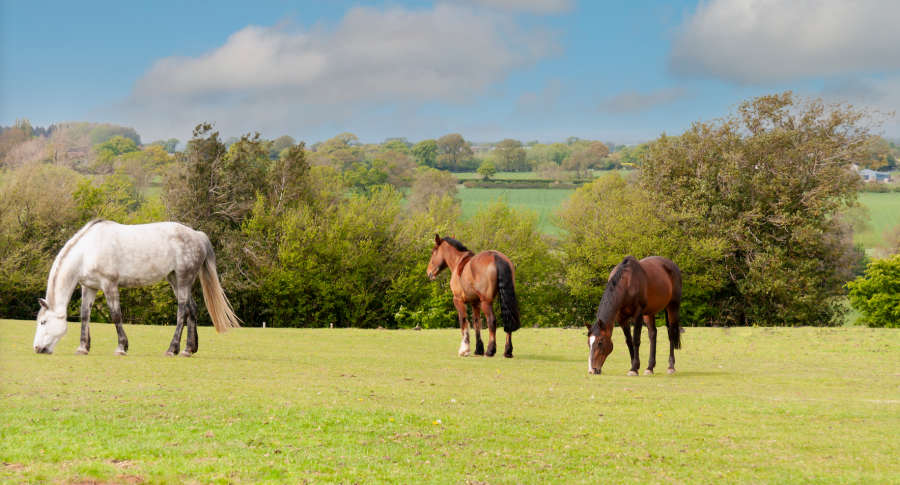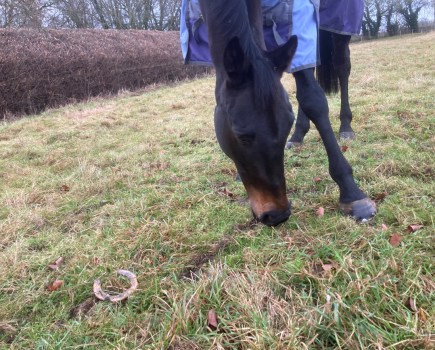Equine metabolic syndrome (EMS) can occur in horses and ponies of all ages, breeds and types. It isn’t a disease itself, but the name given to a collection of risk factors that increases a horse or pony’s likelihood of developing laminitis, which poses a serious threat to horse health.
We now know that over 90% of cases of laminitis occur secondary to underlying hormonal (endocrine) disease, namely EMS, Cushing’s disease, or both. Risk factors include insulin dysregulation in the form of high blood insulin levels or abnormal blood insulin responses, or both, plus obesity, or abnormal fat deposition.
Signs of equine metabolic syndrome
Most horses with equine metabolic syndrome are obese and have regions of abnormal fat deposition. Such fat deposits are generally on the crest of the neck, over the shoulders, over the back musculature and in the rump area.
It is important to remember that some lean horses may also have EMS. These equines tend to have regions of abnormal fat deposition despite their ribs being visible or easily palpable.
It is also worth remembering that not all overweight horses have equine metabolic syndrome, and this highlights the importance of confirming abnormal blood insulin levels by performing the relevant blood tests.
Equine metabolic syndrome: risk factors
EMS was alluded to as early as the 1980s in veterinary literature, but only in recent years has there been an increase in knowledge and awareness of the issue.
An abnormal blood insulin level is integral to the development of laminitis. Some horses with EMS will have persistently high blood insulin levels, whereas in others it may only be evident following a ‘sugar challenge’, such as a period of time at grass.
Experts currently don’t know exactly how abnormal blood insulin levels cause laminitis, but we do know that high blood insulin is associated with episodes of laminitis. Research is ongoing to determine the exact reason why.
Other risk factors for the development of abnormal blood insulin levels include inactivity and ageing.
Which horses are most at risk?
Although any equine can have EMS, we know that there appears to be a higher incidence of it in British native ponies, Shetlands, minis and donkeys.
A scientific study* published in the Equine Veterinary Journal identified the high prevalence of equine metabolic syndrome in UK native ponies and cobs along with a set of risk factors.
The research, which was undertaken in 2020, included 354 horses at 64 properties in the northwest of England and north Wales, including studs, livery yards and riding schools.
Diagnosing equine metabolic syndrome
In an ideal world, a proactive approach would be undertaken to identify horses with EMS, manage the condition and, in turn, prevent the development of laminitis.
Sadly, a diagnosis of EMS is frequently made when a horse or pony has already come down with laminitis. Therefore, if your equine is a good-doer, struggles to lose weight, or has areas of abnormal fat deposition, then you should discuss equine metabolic syndrome with your vet and be pro-active rather than reactive.
EMS is often suspected based on a horse’s history, appearance and clinical examination findings. However, blood work is required to confirm abnormal blood insulin levels.
A number of tests and testing protocols are available, and your vet will be able to discuss the most appropriate one for your horse.
How to manage equine metabolic syndrome
1 Diet
The affected horse’s diet should be closely examined and the necessary tweaks made. Grazing should cease until normal blood insulin results have been obtained and the affected patient has lost weight.
Hay should be fed at a rate of 1.5% of body weight in kilograms per day, and should be weighed dry prior to soaking for 8-12 hours in clean, fresh water in a shaded area. Your horse’s daily requirement should then be fed at regular intervals throughout the day.
Try being inventive in making the hay ration last for as long as possible. There are many ways of achieving this, from double netting or using trickle nets, to placing some of the daily ration in a treat ball and feeding forage cafeteria style in order to mimic the natural roaming horses do in the wild.
If the horse’s previous daily hay intake vastly exceeded the new calculated amount, then reduce gradually to this lower recommended quantity.
If feeding soaked hay, in order to meet the horse’s vitamin and mineral requirements, a low-calorie balancer should also be fed, or, alternatively, a vitamin and mineral powder. Other suitable feeds include light, unmolassed chaff or unmolassed sugar beet pulp.
2 Exercise
Exercise has been proven to improve cellular insulin sensitivity. However, if your horse or pony is actively laminitic, exercise can’t commence until they have been given the all-clear by your vet.
Your horse should then begin an exercise programme that is increased only gradually in intensity in line with their fitness level.
In horses diagnosed with EMS but who don’t actively or haven’t recently had laminitis, then the aim should be that they do at least 20 minutes of continual trot or canter work at least five times per week.
Once visible weight loss has occurred, bloods can be repeated to ascertain the horse’s response to the management changes.
3 Medication for EMS
A number of drug therapies are available for managing equine metabolic syndrome. Metformin, levothyroxine and ertugliflozin are all used, but in the UK their use is currently off-licence.
Drug therapy doesn’t replace diet and exercise, but it can help in severe and non-responding cases, and it can be particularly useful when laminitis occurs but exercise isn’t permitted or possible.
‘He lost a whopping 99kg’
When one of my client’s nine-year-old Welsh gelding developed laminitis in December 2021, blood work confirmed equine metabolic syndrome.
Kye’s resting blood insulin level was 63.9mIU/L (normal being less than 32 mIU/L). Over the years, Kye’s weight had crept up and, at the point of diagnosis, he weighed 602kg. Kye’s owner knew that drastic action was required.
Kye required six weeks’ box rest to allow the laminar inflammation to settle. During this time, he was taken off haylage and placed on a diet of 9kg of hay per day weighed dry and soaked for 8-12 hours before feeding, divided into four small-holed nets. A balancer was also provided.
His owner felt that she was starving Kye, but her determination paid off and six weeks after the diagnosis, a hand-walking exercise programme could begin.
Ten weeks later, a weigh-in showed that Kye had lost 53kg. At this point, swimming rehabilitation at a local centre was introduced.
Using a combination of diet, controlled walking exercise and swimming, Kye lost a whopping 99kg. He was now ready for a further increase in work, including ridden work.
Quality of life
Given Kye’s weight loss and to assist with ongoing loss, his daily forage requirement was reduced to 7.5kg per day of dry hay soaked.
At this point, Kye was being hand grazed, but he began to be turned out in April. Eventually, 45 minutes of loose grazing was permitted with a muzzle in place, but unfortunately Kye suffered a mild laminitic flare-up.
Luckily, this settled following a short period of box rest and a course of oral anti-inflammatory drug therapy.
As a result, Kye was soon able to restart a hand walking exercise programme. Equine metabolic syndrome bloods were repeated, revealing a normal blood insulin result — Kye’s level was now 16.9 mIU/L.
As quality of life is hugely important, Kye restarted hand grazing. This increased to 25 minutes of grazing per day and he was turned out in the field with his pony pal Neville for the first time in several months.
Soon after that, Kye’s owner began riding him again.
Prevention is better than cure
Managing a horse with equine metabolic syndrome requires time, patience and dedication from the owner. Diet and exercise form the cornerstones of management and it is possible to restore a horse or pony to good health.
However, prevention is better than cure and lowering the risk by keeping their weight at a healthy level will go a long way to keeping your horse healthy.
Research links
Related content
- Everything you need to know about laminitis
- Hay vs haylage: which is best?
- Soaking hay: how to do it correctly
- What does fat really do to your horse’s body?
- Why metabolism is important for horse health and four ways to support it
- All about cafeteria-style feeding and its huge health benefits for horses *VIDEO*








